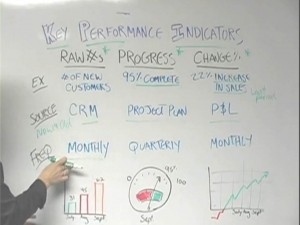 “If you can’t measure it, you can’t manage it.” That’s what Peter Drucker said to clarify the role measurements play in driving business growth.
“If you can’t measure it, you can’t manage it.” That’s what Peter Drucker said to clarify the role measurements play in driving business growth.
But when it comes to the topic of web analytics, measurements can get very confusing very fast. What does a clickstream, CPC or Bounce Rate have to do with sales?
Here are 6 ways to demystify web analytics fast.
 1. KNOW WHY YOUR SITE EXISTS: Is your website for e-commerce, lead generation, new prospects for a new product, a better customer experience or to lower internal overhead. If you are clear why your site exists, you’ve already taken a big step toward clarifying the web analytics most important to measure.
1. KNOW WHY YOUR SITE EXISTS: Is your website for e-commerce, lead generation, new prospects for a new product, a better customer experience or to lower internal overhead. If you are clear why your site exists, you’ve already taken a big step toward clarifying the web analytics most important to measure.
2. IDENTIFY WHO YOU WANT TO ATTRACT AND HOW WELL YOU WANT TO GET TO KNOW THEM. Any business can define their customers according to demographics and psychographics. For example, an audience for a new, compact car might be young adults
 18-34 who relish their independence and, for first time, bought or leased their own car. So what? Web
18-34 who relish their independence and, for first time, bought or leased their own car. So what? Web
analytics can explain how that audience generates greater sales and profitability by showing who is likely to be a loyal customer versus a price shopper? Who will be high maintenance versus an advocate for your brand? In short, web analytics tell you who to spend time pursuing and who not to waste time on. You have to devote time and resources to finding this out but, based on how valuable it is to your business, web analytics are a major asset.
3. FIND OUT HOW THEY FIND YOUR SITE: 80% of traffic to a web site begins with a search query according to Econsultancy. But what caused the consumer to get to your site after that query. Was it where your business stands in the search rankings? A paid search ad? A review on Yelp or a friend’s recommendation on Facebook? The right web measurements answer these questions and tell you how to spend your marketing dollars most effectively.

5. BUILD AN ACTIONABLE SCORECARD: Every business should be guided by Key Performance Indicators. KPI’s are your primary guideposts for success. They also show progress and a difference versus a prior benchmark period. That’s what makes them actionable. Below is how to go about setting up a KPI dashboard which is not be hard to do.
6. CREATE AND KEEP CUSTOMERS: Peter Drucker also said: “The purpose of a business is to create and keep a customer.” The fact is the most eye-catching website, killer marketing plan and fanciest web analytics aren’t worth a dime if a business can’t prove that it satisfies customers. But, if you are focused on customer satisfaction, web analytics can guide you on how to keep them coming, buying more often and making the most of your marketing dollars.
Do these steps help demystify web analytics for you?






Super advice – clear, concise and convincing.
Thanks Jay. Really appreciate the feedback. Rob